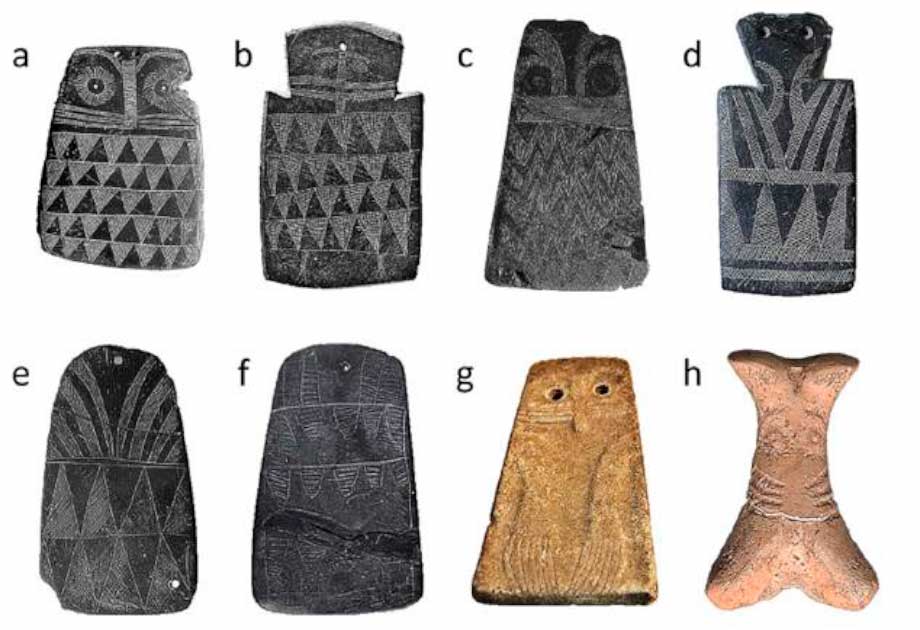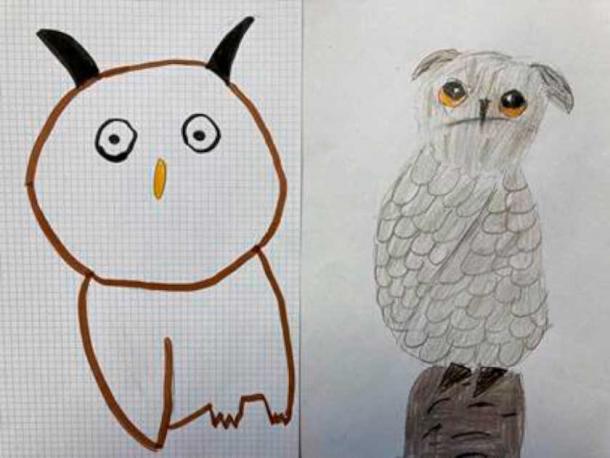Decades of excavations in ancient burial pits in the Iberian Peninsula (modern-day Spain and Portugal) have unearthed more than 4,000 palm-sized slate owl plaques engraved with geometric images of owls. It has long been believed that these 5,000-year-old objects were created for religious or ceremonial rituals, presumably by an owl-worshipping culture . But in a remarkable twist, a team of Spanish scientists have now concluded these iconic amulets were actually made by children as craft projects.
“Contrary to previous interpretations ascribing a highly ritualistic and deep significance to these objects, we suggest that the commonness of the material used and their basic and fast manufacture point to their crafting and use by young members of the community, possibly as dolls, toys, drawings or amulets,” the Spanish scientists wrote in a new article appearing in Scientific Reports .
- A Whopping 25% of Prehistoric Rock Art Could Be Children’s Art, Study
- New Archaeological Method Finds Children Were Skilled Ceramists During the Bronze Age
While they haven’t ruled out the additional use of these ancient owl plaques as votive offerings within burials, this is a most unique hypothesis. Even today, little is known about the contributions of children to the cultures of ancient peoples. It is always assumed that prehistoric objects recovered during archaeological excavations were crafted by adults. This in turn could mean that the purpose of these artifacts may have been misunderstood.

Selection of owl plaques from the Iberian Peninsula. (Juan J. Negro et. al. / CC BY 4.0 )
Fun Times and Owl Plaques in Prehistoric Art Class
The owl plaques in question were first found in excavations that took place in Portugal in the 19th century. Many subsequent digs in Portugal and Spain have produced more samples of these mysterious engraved objects, which have been dated to a narrow period between 5,500 to 4,750 years before the present) in the Chalcolithic or Copper Age .
Discovered within communal megalithic graves, despite their initial purpose, the owl plaques were later considered appropriate for use as burial objects. Over 4,000 of these hand-sized objects have been recovered, all of which featured owl imagery.
The owls on the plaques are not exact recreations of the actual animal, but stylized geometric versions that feature two large circles for eyes, squares or trapezoids for the heads. The owl plaques also feature interlocking triangles to represent the feathers covering the body. The engravings are entirely recognizable as owls, capturing the unique features of an animal that was venerated for its wisdom and perceived god- or goddess-like attributes by many ancient cultures.
Notably, most of the owl plaques have one or two holes drilled into them at the top. This suggests they may have been meant to be worn on strings as amulets. While most were made from slate, a sedimentary rock common to the Iberian region, some of the owl engravings were carved into pieces of sandstone or animal bones.

Drawings of owls by children aged 6 – 9 years. (Juan J. Negro / CC BY 4.0 )
Comparing Ancient Owl Plaques to Modern-Day Children’s Artwork
For the purposes of this new study into the plaques’ origins, the team of Spanish scientists, led by evolutionary biologist Juan Negro from the state-funded Spanish National Research Council (CSIC), performed a detailed examination of approximately 100 owl plaques taken from various museum collections. They wanted to get a better idea of what exactly the engravings on the plaques looked like, so they could compare the images to dozens of modern images of owls drawn by children, ranging in age from 13 years old or younger.
While making this comparison, the scientists were struck by how similar the ancient and modern owl images appeared to be. Just as the plaques showed more details in some cases and less details in others, the scientists noted that modern children tended to create more accurate representations as they got older and became more skilled at art.
The use of geometric shapes to recreate owl features was evident in both ancient and modern representations, suggesting that children both then as now were interested in shapes and liked to portray animals in this way.
The scientists carefully examined the small holes drilled into the top of the plaques, and they are now offering an alternative explanation for their use. They conclude that the shape of the holes would not have made it easy to pass cords through them, and they note that the holes lack the type of wear marks that would have been found if cords for hanging were used.
Negro and his colleagues believe the holes were actually designed so that real owl feathers could be stuck into them, to recreate the tufts of feathers that are found on the heads of several owl species known to be common to the Iberian region.
By piecing together all this information, the scientists proposed that the owl plaques were not the creations of artisans. Instead they concluded that they were made by kids who were either playing around on their own or were assigned to make these objects by the prehistoric equivalent of art teachers.

Two fledglings of the species known as Little Owl (Athene noctua). This common species may have been the model of some engraved slate owl plaques of the Copper Age. (Juan J. Negro / CC BY 4.0 )
Have Archaeologists Underestimated the Cultural Contributions of Children?
It remains to be seen if the conclusions of the Spanish team are accepted by archaeologists and anthropologists who specialize in the study of Copper Age European culture. A 100-percent consensus seems unlikely, given the remote age of the objects and the lack of knowledge about the culture that created them.
Since the mysterious owl plaques were first discovered more than a century ago, many different theories have been offered to explain their origin. Some archaeologists suggested they were a form of decorative jewelry modeled after similar jewelry pieces manufactured in ancient predynastic Egypt . Others said they were most likely recreations of a goddess that was associated with owls, and therefore would have been made to honor that goddess.
- Tibetan Hand and Footprints May Be Oldest Prehistoric Art
- Child Doodles Discovered in 14th Century Manuscript
Some interpretations have concluded that they were religious and symbolic images portraying an animal that was considered sacred in itself, without reference to any god or goddess. A final theory stated they were representations of the dead, made to look like owls because that particular animal was connected somehow to the afterlife in the belief system of the creators.
Even if the new hypothesis is correct, it doesn’t necessary conflict with the idea that the owl imagery had a deeper meaning. If the culture the children came from worshipped owls or associated them with a god or goddess, the children would have been exposed to owl imagery quite often and may have been trying to recreate what they saw all around them in their artistic owl plaques.
The mystery of who made the owl plaques and why may never be definitively solved. But if they were in fact made by children, it raises an interesting question: how many other objects found at archaeological sites around the world were actually made by children instead of adults? It will be interesting to see if the research project undertaken by Juan Negro and his colleagues in Spain is emulated elsewhere, specifically by archaeologists searching for new ways to interpret old discoveries.
Top image: Composite image depicting the similitude between a replica of the Valencian slate owl plaque with inserted feathers (on the left) and the long-eared owl species which may have inspired numerous engraved owl plaques (on the right). Source: Juan J. Negro / CC BY 4.0
By Nathan Falde





